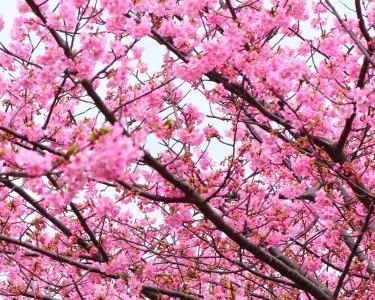Kwanzan cherry (Prunus serrulata 'Kanzan') trees are regarded as some of the most spectacular cherry trees at the National Cherry Blossom Festival due to their breathtaking deep pink double blossoms. surprisingly, Kwanzan cherry trees are attractive throughout the year, with foliage that emerge a rich red-copper color before turning green in the summer and then yellow in the autumn. These trees can be planted as bonsai in a container, in an elegant row, or as specimen trees. They only live for 15 to 25 years, which is unfortunate.
The exquisite shape and abundant foliage of these trees are striking. Their gracefully spreading branches create a charming silhouette that enhances their aesthetic allure even when they are not in bloom. The leaves start out as golden as they sprout but turn rich green as the season goes on, adding aesthetic intrigue all year long.
History
Originally introduced to the United States in the early 20th century, Kwanzan Cherry trees (Prunus serrulata 'Kwanzan') are native to Japan. These decorative trees were given the name Kwanzan after the Japanese mountain of the same name. With their dazzling beauty, they immediately captured the hearts of everyone.

Characteristics
Kwanzan Cherry trees are well known for their stunning flowers. Clusters of double-petaled, soft-pink flowers emerge in the spring, setting off an amazing display against the backdrop of the sky. The blossoms are so plentiful that they nearly have the appearance of clouds, giving any setting a romantic feel.
Pros
Impressive Visual Appeal
With its vivid pink, double-petaled blossoms, the Kwanzan Cherry Tree exudes amazing beauty. These flowers transform any landscape into a breathtaking paradise, making them a popular choice for ornamental use.
Profusion of Blossoms
The Kwanzan Cherry Tree blooms in a spectacular display in the spring. The overwhelming number of flowers adorning the tree can create a breathtaking sight that adds a touch of enchantment to both gardens and parks.
Adaptation to Various Climates
Kwanzan Cherry Trees are adaptable to a variety of climates. They may flourish in a variety of settings, enabling their cultivation in different geographical areas.
Symbolic Value
In many cultures, cherry blossoms—including those of the Kwanzan Cherry Tree—have profound symbolic significance. They frequently stand for rebirth, beauty, and the fleeting essence of life.
Shade Under the Canopy
The Kwanzan Cherry Tree provides plenty of shade throughout the summer thanks to its broad canopy. Due to this characteristic, it serves as a cozy and lovely place to unwind.
Cons
Short Bloom Lifespan
The Kwanzan Cherry Tree produces beautiful blossoms, but they only last for a short time. Although they produce a stunning display, their beauty is transient and only lasts for a few weeks.
Shallow Roots
The Kwanzan Cherry Tree's roots are relatively shallow, which makes it vulnerable to soil compaction and probable harm from foot activity. It is necessary to exercise caution to avoid damaging the tree's roots.
Messy Flower Drop
A vibrant carpet of blooms covers the ground as they fade and fall from the tree. While this may be endearing, it could also call for routine cleaning to keep the neighborhood tidy.
Root Structure
Kwanzan cherry trees have moderately aggressive underground root systems that grow near to the surface. So as to help the roots outcompete the grass, it is advised to place them in a raised mound bed. Kwanzan cherry trees are susceptible to fireblight, root rot, powdery mildew, and leaf curl, among other common ailments.
Problems & Diseases
Blossom Blight
Blossoms may wilt and turn dark due to bloom blight, which is brought about by fungi. To prevent this, remove affected flowers immediately and consider fungicides.
Leaf Spot
Leaf spot, which frequently results from bacteria or fungi, appears as dark lesions on the leaves. Its spread can be slowed down by raking up fallen leaves and making sure there is adequate space between trees.
Dark Rot
A fungus called brown rot causes the fruit to decay and shrivel. Its effects can be reduced by pruning infected branches and keeping proper air circulation.
Infestations of aphids
Aphids are small insects that can yellow and distort leaves by sucking the sap from them. Aphid populations can be reduced by encouraging natural predators like ladybugs and regularly misting the tree with water.
Incorrect watering
The tree may become stressed from inconsistent or excessive irrigation, which increases its susceptibility to diseases. The key to avoiding this is mulching and having a regular watering schedule.
Compacted Soil
The growth of roots and water absorption are hampered by compacted soil. Compaction can be avoided by regularly aerating the soil and limiting foot movement in the area around the tree.







0 Comments
For comments please reply here.......